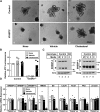Cholesterol auxotrophy and intolerance to ezetimibe in mice with SREBP-2 deficiency in the intestine
- PMID: 28630260
- PMCID: PMC5625122
- DOI: 10.1194/jlr.M077610
Cholesterol auxotrophy and intolerance to ezetimibe in mice with SREBP-2 deficiency in the intestine
Abstract
SREBP-2 activates transcription of all genes needed for cholesterol biosynthesis. To study SREBP-2 function in the intestine, we generated a mouse model (Vil-BP2-/- ) in which Cre recombinase ablates SREBP-2 in intestinal epithelia. Intestines of Vil-BP2-/- mice had reduced expression of genes required for sterol synthesis, in vivo sterol synthesis rates, and epithelial cholesterol contents. On a cholesterol-free diet, the mice displayed chronic enteropathy with histological abnormalities of both villi and crypts, growth restriction, and reduced survival that was prevented by supplementation of cholesterol in the diet. Likewise, SREBP-2-deficient enteroids required exogenous cholesterol for growth. Blockade of luminal cholesterol uptake into enterocytes with ezetimibe precipitated acutely lethal intestinal damage in Vil-BP2-/- mice, highlighting the critical interplay in the small intestine of sterol absorption via NPC1L1 and sterol synthesis via SREBP-2 in sustaining the intestinal mucosa. These data show that the small intestine requires SREBP-2 to drive cholesterol synthesis that sustains the intestinal epithelia when uptake of cholesterol from the gut lumen is not available, and provide a unique example of cholesterol auxotrophy expressed in an intact, adult mammal.
Keywords: Niemann-Pick C1-like 1; SREBP; Scap; cholesterol/biosynthesis; fatty acid/synthesis; organoid.
Copyright © 2017 by the American Society for Biochemistry and Molecular Biology, Inc.
Figures






Comment in
-
The good side of cholesterol: a requirement for maintenance of intestinal integrity.J Lipid Res. 2017 Oct;58(10):1935-1936. doi: 10.1194/jlr.C079715. Epub 2017 Aug 2. J Lipid Res. 2017. PMID: 28768704 Free PMC article. No abstract available.
Similar articles
-
Scap is required for sterol synthesis and crypt growth in intestinal mucosa.J Lipid Res. 2015 Aug;56(8):1560-71. doi: 10.1194/jlr.M059709. Epub 2015 Apr 20. J Lipid Res. 2015. PMID: 25896350 Free PMC article.
-
Regulation of sterol regulatory element-binding proteins in hamster intestine by changes in cholesterol flux.J Biol Chem. 2001 May 18;276(20):17576-83. doi: 10.1074/jbc.M010917200. Epub 2001 Feb 20. J Biol Chem. 2001. PMID: 11278785
-
Insig proteins mediate feedback inhibition of cholesterol synthesis in the intestine.J Biol Chem. 2014 Jan 24;289(4):2148-56. doi: 10.1074/jbc.M113.524041. Epub 2013 Dec 11. J Biol Chem. 2014. PMID: 24337570 Free PMC article.
-
Cholesterol homeostasis by the intestine: lessons from Niemann-Pick C1 Like 1 [NPC1L1).Atheroscler Suppl. 2008 Sep;9(2):77-81. doi: 10.1016/j.atherosclerosissup.2008.05.008. Epub 2008 Jun 27. Atheroscler Suppl. 2008. PMID: 18585981 Review.
-
Zetia: inhibition of Niemann-Pick C1 Like 1 (NPC1L1) to reduce intestinal cholesterol absorption and treat hyperlipidemia.J Atheroscler Thromb. 2007 Jun;14(3):99-108. doi: 10.5551/jat.14.99. J Atheroscler Thromb. 2007. PMID: 17587760 Review.
Cited by
-
A cholesterol-binding bacterial toxin provides a strategy for identifying a specific Scap inhibitor that blocks lipid synthesis in animal cells.Proc Natl Acad Sci U S A. 2024 Feb 13;121(7):e2318024121. doi: 10.1073/pnas.2318024121. Epub 2024 Feb 8. Proc Natl Acad Sci U S A. 2024. PMID: 38330014 Free PMC article.
-
Drivers of transcriptional variance in human intestinal epithelial organoids.Physiol Genomics. 2021 Nov 1;53(11):486-508. doi: 10.1152/physiolgenomics.00061.2021. Epub 2021 Oct 6. Physiol Genomics. 2021. PMID: 34612061 Free PMC article.
-
Intestinal Deletion of 3-Hydroxy-3-Methylglutaryl-Coenzyme A Reductase Promotes Expansion of the Resident Stem Cell Compartment.Arterioscler Thromb Vasc Biol. 2022 Apr;42(4):381-394. doi: 10.1161/ATVBAHA.122.317320. Epub 2022 Feb 17. Arterioscler Thromb Vasc Biol. 2022. PMID: 35172604 Free PMC article.
-
Impact of protein intake from a caloric-restricted diet on liver lipid metabolism in overweight and obese rats of different sexes.Sci Rep. 2025 Jan 17;15(1):2340. doi: 10.1038/s41598-025-86596-6. Sci Rep. 2025. PMID: 39833384 Free PMC article.
-
Step-by-step diagnosis and management of the nocebo/drucebo effect in statin-associated muscle symptoms patients: a position paper from the International Lipid Expert Panel (ILEP).J Cachexia Sarcopenia Muscle. 2022 Jun;13(3):1596-1622. doi: 10.1002/jcsm.12960. Epub 2022 Mar 10. J Cachexia Sarcopenia Muscle. 2022. PMID: 35969116 Free PMC article. Review.
References
-
- Horton J. D., Shimomura I., Brown M. S., Hammer R. E., Goldstein J. L., and Shimano H.. 1998. Activation of cholesterol synthesis in preference to fatty acid synthesis in liver and adipose tissue of transgenic mice overproducing sterol regulatory element-binding protein-2. J. Clin. Invest. 101: 2331–2339. - PMC - PubMed
-
- Yang T., Espenshade P. J., Wright M. E., Yabe D., Gong Y., Aebersold R., Goldstein J. L., and Brown M. S.. 2002. Crucial step in cholesterol homeostasis: sterols promote binding of SCAP to INSIG-1, a membrane protein that facilitates retention of SREBPs in ER. Cell. 110: 489–500. - PubMed
Publication types
MeSH terms
Substances
Grants and funding
LinkOut - more resources
Full Text Sources
Other Literature Sources
Medical
Molecular Biology Databases

